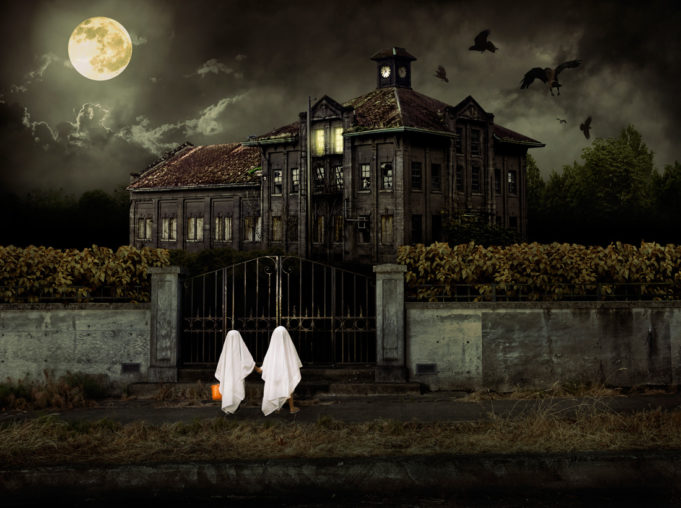Fifty years. It goes by in a flash. Timothy Mark O’Bryan was 8. I was 7.
It was Halloween, 1974. On a Thursday, a school night. Just like the All Hallows’ Eve coming up this year.
I lived in a rural area between Aledo and Weatherford. Timothy lived in Deer Park, part of the burgeoning Greater Houston metropolitan sprawl.
Timothy’s father, Ronald Clark O’Bryan, was an optician by trade and worked at the Texas State Optical in Meyerland Plaza in Houston. Ronald’s somewhat dour countenance — reminiscent of a doughy, drab Perry Mason — masked a wonderful singing voice. Today, he might have auditioned for American Idol or America’s Got Talent, but back then, he had to settle for being a soloist at the Second Baptist Church in Deer Park, where he was also in charge of the bus program.
By all accounts, Timothy’s father Ronald seemed like an All-American dad.
But the American Dream is expensive, and Ronald wasn’t good with money. He was behind on loans, saddled with increasing debt, and his car was about to be repossessed. He’d already sold the family’s home. No amount of praying or belting out Bible hymns was going to fix this, so he pursued a rather unorthodox business opportunity.
Several months before Halloween, Ronald began taking out life insurance policies on his children, Timothy and 5-year-old daughter Elizabeth. Then Ronald began researching cyanide. He discussed it with a co-worker. He telephoned a friend who worked at a chemical company and inquired about the poison, even asking about lethal dosages. Ronald even made a trip to a Houston chemical supply and approached a salesperson about purchasing some of the deadly substance.
And so it went.
Optician by workday, cherished church parishioner on Sunday, and troubled though reportedly loving father at home.
A few months before Halloween, Ronald purchased additional $20,000 life insurance policies on Timothy and Elizabeth. He paid cash for both but didn’t tell his wife, Daynene.

*****
Halloween day in the Houston area in 1974 was warm, mid-70s to low 80s. By the time evening came around, it was raining, but the suburban Houston streets were filled with miniature ghosts, goblins, astronauts, Wonder Women, Supermen, and even some Evel Knievels. Nearby Pasadena was a Halloween hot spot, and Ronald decided to take Timothy and Elizabeth to trick-or-treat there with a Pasadena resident named Jim Bates and his son. Ronald was still wearing his white optician’s lab coat.
The kids were having fun going from house to house with other kids. Then Ronald’s crew came to a residence where no one responded to their Halloween hails. They gave it a minute, knocked again, and then went on — but Ronald didn’t want to give up or maybe said he thought he heard something. He decided to wait, just to be sure, and sent his friend and all three kids on to the next house.
In a few minutes, Ronald caught up to them. His patience had apparently paid off. He’d hit the proverbial jackpot. He said the residents had finally come to the door and given him five giant Pixy Stix!
“You must have some rich neighbors,” Ronald commented to Bates, giving each kid a stick, and they went on to the next house.
Though All Hallows’ Eve had fallen on a Thursday night that year, it was a sweet success for Ronald and his neighbor’s children. They only had to trick-or-treat down two streets to fill their bags.
Later, when Ronald, Timothy, and Elizabeth returned home, Timothy wanted to eat some of his candy. Ronald reportedly allowed him to have one piece. Timothy chose the giant Pixy stick.
Timothy had problems getting it open, so his father opened it for him.
When Timothy held the tail end of the giant stick up to pour some of the open end into his mouth, he immediately complained. Nothing came out. Ronald took the stick, obligingly rolled the oversized plastic straw-like container between his palms to loosen its contents, then handed it back to his son. Timothy tipped the candy container back up and poured some of it into his mouth.
Timothy smacked his lips. “Oh, Daddy,” he said. “That’s bitter.”
Ronald gave him some Kool-Aid to wash it down.
Timothy gasped and immediately started vomiting. Within moments, his small frame was wracked by convulsions. Ronald called an ambulance.
Ronald reportedly held Timothy in his arms until the first responders arrived. The boy went limp and was dead in less than an hour.
*****
The O’Bryans were well known in Deer Park, and the community was shocked. The alarming news spread fast and remarkably far. The initial narrative — for Ronald’s part, anyway — was ingenious. An 8-year-old boy had been poisoned by tainted Halloween candy, and reporters came from as far away as London and Germany. Parents across America were terrified and aghast, and churchgoers of every faith were outraged, claiming they weren’t surprised that such a thing could happen on a Satanic, pagan holiday.
Untold tons of Halloween candy from homes across America were tossed out summarily, and legions of prepubescent trick-or-treaters protested en masse. When the Pasadena police made an appeal to the citizenry to bring in suspicious treats, the candy delivered was enough to fill an entire squad room.
Every other giant Pixy stick Ronald had reportedly received from the house he’d patiently waited at was recovered unopened, and each contained quantities of cyanide capable of killing two or three adults.
Ronald O’Bryan tried to collect on one of the insurance policies he’d taken out on Timothy less than 11 hours after the boy’s death, but he really hadn’t thought things through.
The notoriety and hellish hoopla that accompanied Timothy’s grotesque demise didn’t shellshock local law enforcement for long. They wanted Ronald to take them to the house where he’d received the poisoned Pixy treats. First, Ronald said he couldn’t remember, but Ronald and Bates had taken their kids trick-or-treating on only two streets. Then, the story Ronald concocted to present the poisoned candy to the kids completely backfired.
The residence Ronald identified belonged to a man named Courtney Martin, who happened to be a p.m. shift supervisor at Hobby Airport. Martin had more than 200 witnesses who could vouch for his whereabouts, and things went swiftly downhill from there.
The police found out about Ronald’s financial problems and mounting debts. They also discovered the recent life insurance policies he had purchased on his children.
Ronald denied everything, at first, and then only admitted to purchasing the insurance policies. He steadfastly maintained his innocence. Presumably inspired, he dedicated the next solo he sang at his church to Timothy. He performed a moving rendition of “Blessed Assurance” in front of the congregation, changing the chorus of “This is my story, this is my song” to “This is Tim’s story, this is Tim’s song.” It was a brilliant piece of stagecraft that reportedly left nary a dry eye in the church.
The Pasadena police kept digging, and Ronald’s neighbors and fellow parishioners were incredulous. “I’ll not believe it,” said one resident, “until I hear it from his own lips.”
Ronald was jailed and indicted for the murder of his son and the attempted murder of the other children. When detectives shared the evidence with his wife Daynene, she said, “Oh, my God, no” and lowered her head, visibly distraught.
When she was able to gather herself, Daynene told the Pasadena police that Ronald had problems. She said her husband exaggerated things and was a spendthrift. She also said that he was in constant financial trouble and had started and lost more than 20 jobs in the last five years. And it went further. Ronald had collected on two insurance claims involving fires that destroyed furniture.
In the ensuing trial, Daynene O’Bryan testified that her husband asked her how the insurance money should be spent before Timothy’s funeral. Another relative testified that on the actual day of Timothy’s funeral, Ronald asked them if the insurance money should be used to pay off bills or buy a new house.
Ronald denied all the charges, but the Harris County district attorney caught him lying more than once during cross examinations. The jury deliberated for less than hour and found Ronald guilty. During the punishment phase of the trial, the DA asked for a death sentence because, as he put it, Ronald ought to be damned to Hell.
“It is the most despicable crime I ever heard of,” the DA added, “to take the life of your own flesh and blood for money.”
*****
The night of Timothy O’Bryan’s murder, Ronald may have looked like he was dressed up for Halloween in his lab coat, but it probably helped him conceal the giant Pixy Stix. Investigators never pinpointed how Ronald acquired the cyanide, but the circumstantial evidence and corroborating eyewitness testimony were overwhelming.
Over the next several years, Ronald’s conviction was appealed in the state courts and, eventually, to the U.S. Supreme Court, which refused to review the case. On September 30, 1984, State District Judge Michael T. McSpadden set Ronald O’Bryan’s execution date for October 31, exactly eight years after his heinous, financially motivated act of filicide.
“I picked it for you, especially,” Judge McSpadden informed Ronald at the sentencing hearing, but Ronald was granted another appeal and continued to insist he had “absolutely nothing” to do with the crime.
Dubbed the “Candy Man” and often referred to as “The Man Who Killed Halloween,” Ronald O’Bryan exhausted his appeals in early 1984 and was executed by lethal injection on March 31. Ronald’s final meal included steak and Boston cream pie.

*****
This approaching Halloween will mark exactly 50 years since the original Houston “Candy Man” struck, and I can’t say it’s far from my mind. A line from Nicola Yoon’s 2016 book The Sun Is Also a Star comes to mind: “Growing up and seeing your parents’ flaws like is like losing your religion.”
In this life, Timothy O’Bryan died without ever knowing his father was a murderer, much less his murderer. In the next life, did Timothy get to see Ronald perform his theatrical version of “Blessed Assurance”?
“Perfect submission, perfect delight … Visions of rapture now burst on my sight”? Or “Blessed assurance / Jesus is mine … Oh, what a foretaste of glory divine”?
I think Timothy might have preferred Boston cream pie, but my family wasn’t religious.
Back then, my dad and mom drove my brother and me to Fort Worth to trick-or-treat. There were more neighborhoods, and the houses were closer together. My Halloween that year — unlike Timothy’s — was excellent. Nice crowds, great treats, and some houses where the residents really went all out to make their places creepy. I remember open garages converted into dungeons. Figures you assumed were stationary playfully lunging at you but making you almost jump out of your costume.
I remember weird, wax harmonica treats and Sweet Tarts. I remember Marathon Bars and Pop Rocks. It’s five decades ago, but I still recall it all and especially what happened to Timothy O’Bryan.
The scariest thing about his Halloween was his father.
And what came after wasn’t much better. Trick-or-treating was discouraged in innumerable American towns and cities. In 1975, the city of Houston hosted a Halloween party at the Astroworld amusement park to cut down on trick-or-treating. In other parts of the nation, schools held on-campus parties to discourage trick-or-treating.
One Texas patriarch’s act of filicide via cyanide evolved into tales of dangerous pills handed out as candy and pins and razor blades inserted in apples. In a ludicrously paranoid, major way, tricks were taken out of treats, trick-or-treaters were egregiously short-changed, and All Hallows’ Eve was changed forever.












